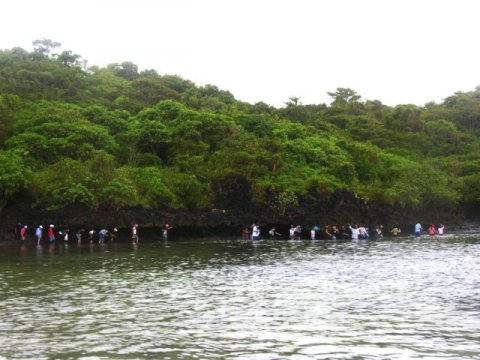REFORESTING THE SEA

NSTP students replanting the rocky shoreline of the Visayas Sea in the Philippines.
BY MAY BELLE GUILLERGAN
The University of Philippines is doing pioneering work in rehabilitating precious mangroves in oil-spill affected areas near the Visayas sea.
Several efforts have started in the Philippines in response to the threats of climate change.
Proper waste management, energy conservation and mountain reforestation projects begin to grow as Filipinos become aware of the effects of global warming, in the fear that the thousands of paradise islands might soon submerge underwater.
Yet we must also be aware that the earth's surface is actually 71% water and 29% land. The earth looks like a blue marble when seen from space and we seem to have overlooked our responsibility to this vast portion of the earth.
My grandfather, who was a fisherman in his lifetime, had once told me, “These waters are the earth's life source. Without the sea, the earth is just one lifeless ball. Look at how we humans flock to the sea. Where there is water, there is habitation. That's because we need it.”
The wisdom of these words was made clear when in August 11, 2006, amidst a strong typhoon, the oil tanker M/T Solar 1 sank at Guimaras Strait.
The intensity of the typhoon that year was unexpected since August used to be the tail month of the typhoon season.
Unseasonal typhoons
Heavy rains used to arrive and intensify in the months of June and July and would subside in scattered heavy rains in August.
Nowadays, heavy gushes of typhoon occur in August and may continue even until October. In this event, the M/T Solar 1 sea disaster lessened food supply and deterred livelihood.
Oil disaster
The sunken vessel spread oil in the Visayas Sea, which is considered a rich fishing ground that supplies most of the fisheries demand for the entire country.
The oil tanker was carrying more than two million liters of bunker fuel. Some 500,000 liters of oil poured into the strait.
The remaining 1.5 million liters from the tanker, sunk at a depth of more than 600 meters, was siphoned in March 2007.
Vulnerable marine sanctuaries
In this span of time, the oil spill has adversely affected marine sanctuaries and mangrove reserves in three out of five municipalities in Guimaras Island and reached the shores of Iloilo (in Panay Island) and Negros Occidental.
In response to this, the University of the Philippines Visayas organized in 2006 the UPV Oil Spill Response Program, an academic program and organization that works toward research and implementation of proper means in rehabilitating mangroves in the oil spill affected areas.
Mangroves' wave energy
Mangrove growths are forests by the sea. Mangroves protect coastal areas from erosion, storm surge and tsunamis. The mangrove's massive root system is efficient at dissipating wave energy.
They could likewise slow down tidal water enough that its sediment is deposited as the tide comes in, leaving all except fine particles when the tide ebbs. Through this, mangroves help in keeping the shorelines clean and the waters pristine clear.
Oil spill response programme
Because of the uniqueness of mangrove ecosystems and its role in protecting land from sea disasters, UPV Oil Spill Response Program has utilized NSTP enrollees (an academic civic program required for college students) in oil spill clean-up efforts and in planting of mangrove propagules (the tubelike mangrove fruit) to stimulate increase of shrub growth in barren rocky coastlines.
These students are taught how mangroves propagate and they participate in “tree planting excursions.”
The program plans to extend rehabilitation efforts to Boracay Island, whose mangrove growth has long been affected by tourism. Should this be pushed through, it is hoped that the island would gain back the cleanliness of its surrounding waters.
In a recent interview with Dr. Resurreccion Sadaba, UPV Oil Spill Response Program manager based in Taklong Island (an islet belonging to Guimaras), he pointed out that aside from the program's goal to research for effective rehabilitation methods, it further seeks to:
(1) promote planting in former mangrove areas, and reverting abandoned, idle and unproductive aquaculture ponds to mangrove growth areas;
(2) improve management schemes by formulating resource management plan and enhancing community participation; and
(3) incorporate periodic project evaluation.
Three years after the disaster, Dr. Sadaba said, “There are good signs showing recovery but studies show continued stress to marine resources brought by the oil contamination. The efforts rendered by the NSTP students though bring definite hope.”
This is an endeavor worth promoting. We do not want the earth to become just one lifeless ball.
May Belle Guillergan is an assistant professor at the University of the Philippines, currently on leave for the Erasmus Mundus Programme and has worked part-time at ABS-CBN Iloilo as a scriptwriter.